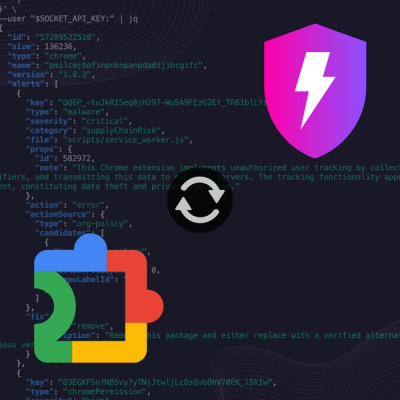
Product
Socket Now Protects the Chrome Extension Ecosystem
Socket is launching experimental protection for Chrome extensions, scanning for malware and risky permissions to prevent silent supply chain attacks.
leaflet-geotiff-2
Advanced tools

A LeafletJS plugin for displaying geoTIFF raster data. Data can drawn as colored rasters or directon arrows. The layer can be clipped using a polygon.

As of version 1, leaflet-geotiff-2 is now under CSIRO's Open Source Software Licence Agreement, which is a variation of the BSD / MIT License.
There are no other plans for changes to licensing, and the project will remain open source.
Dependencies must be loaded:
import "leaflet-geotiff-2";
// optional renderers
import "leaflet-geotiff-2/dist/leaflet-geotiff-rgb";
import "leaflet-geotiff-2/dist/leaflet-geotiff-vector-arrows";
import "leaflet-geotiff-2/dist/leaflet-geotiff-plotty"; // requires plotty
Parameters:
// GeoTIFF file URL. Currently only EPSG:4326 files are supported
// Can be null if sourceFunction is GeoTIFF.fromArrayBuffer
const url =
"https://stuartmatthews.github.io/leaflet-geotiff/tif/wind_speed.tif";
const options = {
// See renderer sections below.
// One of: L.LeafletGeotiff.rgb, L.LeafletGeotiff.plotty, L.LeafletGeotiff.vectorArrows
renderer: null,
// Use a worker thread for some initial compute (recommended for larger datasets)
useWorker: false,
// Optional array specifying the corners of the data, e.g. [[40.712216, -74.22655], [40.773941, -74.12544]].
// If omitted the image bounds will be read from the geoTIFF file (ModelTiepoint).
bounds: [],
// Optional geoTIFF band to read
band: 0,
// Optional geoTIFF image to read
image: 0,
// Optional clipping polygon, provided as an array of [lat,lon] coordinates.
// Note that this is the Leaflet [lat,lon] convention, not geoJSON [lon,lat].
clip: undefined,
// Optional leaflet pane to add the layer.
pane: "overlayPane",
// Optional callback to handle failed URL request or parsing of tif
onError: null,
// Optional, override default GeoTIFF function used to load source data
// Oneof: fromUrl, fromBlob, fromArrayBuffer
sourceFunction: GeoTIFF.fromUrl,
// Only required if sourceFunction is GeoTIFF.fromArrayBuffer
arrayBuffer: null,
// Optional nodata value (integer)
// (to be ignored by getValueAtLatLng)
noDataValue: undefined,
// Optional key to extract nodata value from GeoTIFFImage
// nested keys can be provided in dot notation, e.g. foo.bar.baz
// (to be ignored by getValueAtLatLng)
// this overrides noDataValue, the nodata value should be an integer
noDataKey: undefined,
// The block size to use for buffer
blockSize: 65536,
// Optional, override default opacity of 1 on the image added to the map
opacity: 1,
// Optional, hide imagery while map is moving (may prevent 'flickering' in some browsers)
clearBeforeMove: false,
};
// create layer
var layer = L.leafletGeotiff(url, options).addTo(map);
Methods - L.leafletGeotiff
| method | params | description |
|---|---|---|
getBounds | get leaflet LatLngBounds of the layer | |
getMinMax | get min max values in data (ignores noDataValue if defined) | |
getValueAtLatLng | (lat: {Number}, lng: {Number}) | get raster value at a point* |
Useful for single-band raster data.
const options = {
// Optional. Minimum values to plot.
displayMin: 0,
// Optional. Maximum values to plot.
displayMax: 1,
// Optional flag for plotty to enable/disable displayMin/Max.
applyDisplayRange: true,
// Optional. If true values outside `displayMin` to `displayMax` will be rendered as if they were valid values.
clampLow: true,
clampHigh: true,
// Optional. Plotty color scale used to render the image.
colorScale: "viridis",
};
const renderer = L.LeafletGeotiff.plotty(options);
Methods - leafletGeotiff.plotty
| method | params | description |
|---|---|---|
setColorScale | (colorScale: {String}) | set layer color scale |
setDisplayRange | (min: {Number}, max: {Number}) | set layer display range |
setClamps | (clampLow: {Boolean}, clampLow: {Boolean}) | set layer clamp options |
getColourbarDataUrl | (paletteName: {String}) | get a data URI for a color palette (e.g. to display colorbar). |
getColorbarOptions | get list of available color palettes |
New color scales can be created using plotty's addColorScale method.
Useful for multi-band raster data (e.g. true color).
RGB renderer options must currently be added by extending L.leafletGeotiff options.
const renderer = L.LeafletGeotiff.rgb();
const options = {
// Optional, band index to use as R-band
rBand: 0,
// Optional, band index to use as G-band
gBand: 1,
// Optional, band index to use as B-band
bBand: 2,
// band index to use as alpha-band
// NOTE: this can also be used in combination with transpValue, then referring to a
// color band specifying a fixed value to be interpreted as transparent
alphaBand: 0,
// for all values equal to transpValue in the band alphaBand, the newly created alpha
// channel will be set to 0 (transparent), all other pixel values will result in alpha 255 (opaque)
transpValue: 0,
renderer: renderer,
};
// create layer
var layer = L.leafletGeotiff(url, options).addTo(map);
For plotting velocity (i.e. quiver plot)
const options = {
// Optional, size in pixels of direction arrows for vector data.
arrowSize: 20,
};
const renderer = L.LeafletGeotiff.vectorArrows(options);
L.LeafletGeotiffRenderer.npm install
npm run build
This repo is an attempt to pull together a bunch of community-driven improvements that
have been made in various forks of leaflet-geotiff over the years but have failed to
make it back into the leaflet-geotiff npm package, and to provide a place for active development for new features.
CSIRO Open Source Software Licence Agreement (variation of the BSD / MIT License)
FAQs
A LeafletJS plugin for displaying geoTIFF raster data.
The npm package leaflet-geotiff-2 receives a total of 133 weekly downloads. As such, leaflet-geotiff-2 popularity was classified as not popular.
We found that leaflet-geotiff-2 demonstrated a not healthy version release cadence and project activity because the last version was released a year ago. It has 1 open source maintainer collaborating on the project.
Did you know?

Socket for GitHub automatically highlights issues in each pull request and monitors the health of all your open source dependencies. Discover the contents of your packages and block harmful activity before you install or update your dependencies.

Product
Socket is launching experimental protection for Chrome extensions, scanning for malware and risky permissions to prevent silent supply chain attacks.

Product
Add secure dependency scanning to Claude Desktop with Socket MCP, a one-click extension that keeps your coding conversations safe from malicious packages.

Product
Socket now supports Scala and Kotlin, bringing AI-powered threat detection to JVM projects with easy manifest generation and fast, accurate scans.